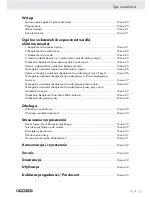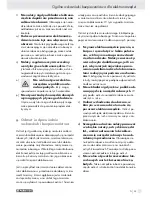
11
GB
General safety advice for electrical power tools
a)
Maintain a firm grip on the electrical
power tool and position your body
and arms to allow you to resist kick-
back forces. Always use the auxiliary
handle, if provided, to exercise the
greatest possible control over kick-
back forces or reaction torques as the
device builds up to full speed.
By taking
suitable precautions the operator can control
kickback and reaction forces.
b)
Do not place your hands near a rotat-
ing attachment.
If kickback occurs the at-
tachment could move over your hand.
c)
Avoid positioning your body in the
area into which the electrical power
tool would move in the event of a
kickback.
A kickback moves the electrical
power tool in the opposite direction to the di-
rection of movement of the grinding disc at the
point of constraint.
d)
Work particularly carefully in the
area of corners, sharp edges etc. to
avoid the attachment bouncing or
snagging on the workpiece. Corners,
sharp edges or bouncing have a ten-
dency to snag the rotating attachment.
This causes loss of control or kickback.
e)
Do not use saw-chain woodcarving
discs or toothed discs.
Such attachments
create frequent kickback and loss of control.
Special safety advice relating
to grinding and disc-cutting
a)
Always use the guard designed for
the type of abrasive consumable you
are using.
Always use abrasive consumables
approved for use with your electrical power
tool. Abrasive consumables not approved for
use with your electrical power tool cannot be
adequately guarded and are unsafe.
b)
To ensure the highest level of opera-
tional safety, the disc guard cover
must be attached to the electrical
power tool and set in such a way that
the smallest possible area of the
abrasive consumable is exposed to
the operator.
The disc guard cover is there
to protect the operator from pieces breaking
off and accidental contact with the abrasive
consumable.
c)
Abrasive consumables must be used
only for their recommended purpos-
es, For example: never grind with the
side face of a cutting disc.
Cutting discs
are intended for removing material using the
edge of the disc. Sideways forces on these
abrasive consumables can cause them to break.
d)
Always use an undamaged mounting
flange of the correct size and shape
for your selected grinding disc.
Suitable
flanges support the grinding disc and reduce
the chance of it breaking. Flanges for cutting
discs are different from the flanges for other
abrasive discs.
e)
Do not use chainsaw blades or serrat-
ed saw blades.
Such insertion tools often
cause the tool to recoil or you to lose control of
the power tool.
Further special safety
advice for disc-cutting
a)
Avoid snagging the cutting disc and
do not use too much contact pressure.
Do not attempt to make excessively
deep cuts.
Overloading the cutting disc in-
creases the load and the tendency of the disc
to twist or snag in the cut, making kickback or
disc breakage more likely.
b)
Avoid the area in front of or behind
the rotating cutting disc.
If the cutting disc
is moving away from you at the point of con-
straint in the workpiece, then, in the event of
a kickback, the electrical power tool and the
rotating disc may be thrown towards you.
c)
If the cutting disc jams or you stop
work for a while, switch the device
off and hold it until the disc comes to
a complete stop. Never attempt to
pull the still rotating cutting disc out of
the cut as this could cause kickback.
Determine and rectify the reason for the jamming.
Содержание PWS 1010 - MANUEL 2
Страница 3: ...A B 9 2 5 6 7 8 C D 6 10 1 3 4...
Страница 4: ...E F G...
Страница 34: ...34...
Страница 48: ...48...
Страница 62: ...62...
Страница 76: ...76...
Страница 90: ...90...












































